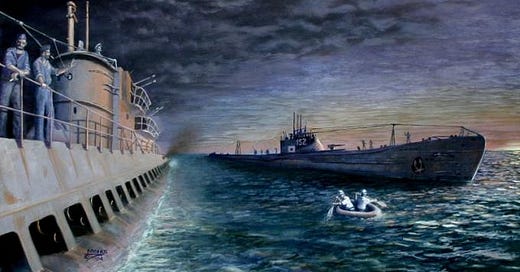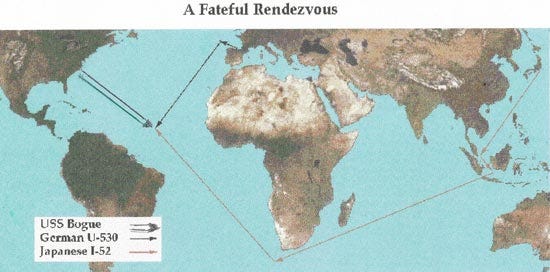There are so many stories from WWII that it is easy to miss the details behind little interesting mentions you may read of now and then in passing.
The exchange between Germany and Japan by submarine is one of them. Epic, but still a background story.
This is a story I really want folks to take time to examine. It brings together all sorts of threads and everyone - friend and foe - in this story are simply fullbore professionals.
We have a lot of Salamander favorites in this story.
First let’s look at the friendly side. We have:
the war-winning allied code breakers who were reading the German’s secure communications.
a representative of an unsung hero of the war, our CVE, in this case the lead of her class, the 645 foot USS Bogue (CVE 9) and her embarked airwing of ~two dozen aircraft.
the multi-mission aircraft that did almost everything, the Grumman TBF Avenger (the same aircraft type President Bush 41 took to war in the Pacific).
as you’ll see in the video below - the technics developed in the early years of air ASW search, localization, tracking, and attack that is still in use today.
On the Axis side:
the historic German Type IXC/40 U-boat U-530.
the exceptional Japanese Type-3 cargo submarine I-52. These submarines were beasts - with roughly 50% more displacement than the GATO Class SS.
What was the I-52 up to? Khalid Elhassan gives a good summary;
On March 10th, 1944, the I-52 left Kure naval base in Japan on her maiden mission. Captained by Commander Uno Kameo and crewed by 94 officers and men, the vessel had a long journey ahead of her, most of it through hostile waters. From the Sea of Japan, she was to head to the East China then South China seas. After a stop in Singapore, the I-52 was to cross the Bay of Bengal, traverse the Indian Ocean, round the Cape of Good Hope and enter the Atlantic. Then she would traverse most of the length of that ocean, before finally entering the Bay of Biscay and docking in the Nazi-controlled French port of Lorient. Her estimated date of arrival was June 6, 1944.
In her cargo hold, the I-52 carried 11 tons of tungsten, almost 10 tons of molybdenum, 3 tons of opium, and 54 kilograms of pure caffeine. She also carried 146 bars of gold, weighing 2.2 tons, intended as payment for German optical technology. In Singapore, she also picked up 3.3 tons of quinine, 60 tons of raw rubber, and 120 tons of tin. She also carried 14 passengers, mostly Japanese technicians, sent to study advanced German torpedo boat engine and antiaircraft gun technologies.
Awaiting the I-52 in Lorient, to carry back home to Japan, were about 40 tons of advanced Nazi technology, plus assorted secret documents, drawings, and schematics. The cargo for the return voyage included German radar equipment, vacuum tubes, optical glass, bombsights, chemicals, a Jumo 213-A engine used in the FW-190D fighter, and T5 acoustic torpedoes that could home in on the sound of ship propellers.
…
the cargo for the return trip included 1760 pounds of uranium oxide. That amount of unenriched uranium oxide would not have been enough for an atomic bomb – assuming the Japanese knew how to build one, which they did not. However, the Japanese could have used that material to create poisonous fission byproducts, that could have then been employed in radiological weapons like “dirty bombs”, for use against the US. Fortunately for the US, and unfortunately for the I-52, the Allies were tipped off about the Japanese submarine’s mission.
The code breakers did their job … and the US Navy set their trap;
On June 6, 1944, the Japanese naval attache in Berlin signaled the submarine that the Allies had landed in France, and advised her to make plans to head for German-occupied Norway, instead. En route, she was to meet up with a German submarine, the U-530, on June 22. The I-52 acknowledged receipt of the message, fatally including her position in the reply.
American intelligence intercepted that exchange and began vectoring a submarine hunter-killer group to find the I-52. Centered around an American escort carrier, the USS Bogue, accompanied by five destroyers, the task group was en route from the US to Europe, when it was tasked with a new mission. On June 15th, following a brief stop in Casablanca, the Bogue group sailed out to begin its hunt. It was a highly successful team of submarine killers, that had sunk a Japanese submarine just a month earlier, on May 13th. Between February 1943 and July 1945, the Bogue team would send 13 German and Japanese submarines to the bottom of the sea.
As directed, the I-52 met up with the German U-530 on the night of June 22nd, about 850 miles west of the Cape Verde Islands. The U-boat topped off the Japanese submarine’s fuel tanks, furnished her with an Enigma coding machine, plus a radar detector, two radar operators, and a German liaison officer to help get her through the Bay of Biscay. The following evening, June 23rd, the Bogue submarine killer group reached the area of the meeting, and began hunting.
For anyone in the surface or aviation side of the house who have done ASW, this all sounds very familiar.
At around 10 PM, June 23, the Bogue launched Grumman TBF Avenger torpedo bombers to try and find the enemy submarines. The U-530 slipped away undetected, but at 11:40 PM, an Avenger piloted by Lieutenant Commander Jesse D. Taylor got a surface contact on its radar, about 10 miles away. Taylor homed in on the radar blip, got there within minutes, then dropped flares to illuminate the area. By their glare, the surfaced I-52 became visible to the naked eye. Taylor immediately dropped sonobuoys – a type of underwater microphone that picks up propeller sounds and transmits them to an airplane – then began his attack.
Yes … by the middle of WWII there were sonobuoys and … homing torpedoes.
From here are want to turn things over to the remarkable video below. Top off your drink and come back. Simply outstanding. It includes the Avenger’s audio during the attack phase and great diagrams of how they executed their localization and attack.
Of course … the gold that went down with the I-52 kept everyone’s attention - and other reasons. As the news of this week has reminded all, technology today is opening up the seabed to explorers of all kinds.
Take time to read this account how 17,000 feet down, they found the wreck of the I-52, and the very honorable act those who found the wreck did to honor the crew of the I-52. Yes, they fought for the Axis, but they were Sailors who did their job honorably, worthy of respect. Of note, the Titanic is only at 12,500 feet.
Professionals all; fullbore.






What an incredible story. Very impressive video and supporting documentation Thanks for a great FBF.
ASW- that surprising act of war predicated on 50% probability of detection. Kudos to Tidwell for not revealing the location and/or ripping it open to find the gold.
And despite The Longest Day, Saving Private Ryan, and all the dog faced soldiers that gave their all on the beaches of Omaha, the hedge rows, March to the Rhine, Tarawa and Iwo Jima, the war was won at Bletchley Park and Station Hypo.
Full Bore Saaa-lute!